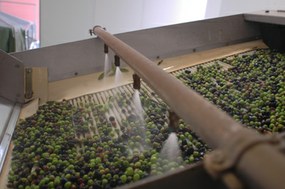ENERGY: ENEA-patented technology to produce methane from olive mill wastewater
11/5/2015
A fuel gas mix from olive mill wastewater, i.e. how to convert a highly-polluting substance into energy. A technology patented by the ENEA Nuclear Technologies Laboratory as a solution to the environmental impact of olive mill wastewater.
In order to reduce treatment costs, olive mill wastewater is released on farming soils in a controlled way for its action as both fertilizer and herbicide; yet such an operation can cost up to 10 €/m3, besides some negative aspects that must be stressed: soil composition can be altered, water bodies risk to be contaminated, the relevant regulations are barely enforced.
 “According to a study by researchers of the University of Thessaloniki [1] 1 m3 of olive mill wastewater has the same polluting ‘potential’ as 100-200 m3 of urban wastewater – says Silvano Tosti, ENEA expert researcher – Yet, if properly pre-treated, such wastewater can be used to produce a gas mix (syngas) rich in hydrogen, CO2, methane, CO, and other gases, to be used for energy purposes”.
“According to a study by researchers of the University of Thessaloniki [1] 1 m3 of olive mill wastewater has the same polluting ‘potential’ as 100-200 m3 of urban wastewater – says Silvano Tosti, ENEA expert researcher – Yet, if properly pre-treated, such wastewater can be used to produce a gas mix (syngas) rich in hydrogen, CO2, methane, CO, and other gases, to be used for energy purposes”.
Specifically, approximately 18 m3 of hydrogen have been produced from 1 m3 of olive mill wastewater in laboratory tests [2]: according to this process, wastewater is first filtered and concentrated and then sent to a fixed-bed catalytic reactor, where the gas mix is produced through steam reforming reactions.
Actually, the olive mill wastewater is a biomass composed of organic substance and water which, once vaporized, reacts in the presence of proper catalysts ; this is the case of the steam reforming that converts the organic compounds into syngas. If a membrane reactor is used, ultra-pure hydrogen can be directly separated obtaining high reaction yields.
The energy needed for the reforming process, heavily affecting the operation costs, can be supplied by burning olive pomaces (the solid olive mill waste) and part of the syngas produced.
For further information, please contact:
Silvano Tosti, Frascati Research Centre, silvano.tosti@enea.it
 A truly energetic kind of … oil!, Energia Ambiente e Innovazione, 6/2014
A truly energetic kind of … oil!, Energia Ambiente e Innovazione, 6/2014
[1] E. Tsagaraki, H. N. Lazarides, K. B. Petrotos (2007). Olive mill wastewater. In V. Oreopoulou & W. Russ (Eds.), Utilisation of by-products and treatment of waste in the food industry (pp. 133–157). Springerlink: http://link.springer.com/chapter/10.1007%2F978-0-387-35766-9_8#page-1
[2]
link:doi:10.1016/j.ijhydene.2013.06.027
